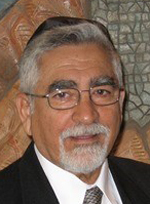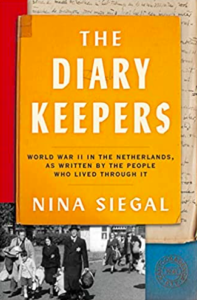By Dorian de Wind

AUSTIN, Texas — The horrors inflicted upon Dutch Jews during the Holocaust were staggeringly evil, nothing short of genocidal.
When Germany invaded the Netherlands in May 1940, 140,000 Jews were living there. In September 1944, when the last transport left for the Nazi death camps, a total of 107,000 Jews had been sent there. Of those, more than 102,000 were murdered and only 5,000 returned after the war. Simply put, if one can do such, 75% of Dutch Jews perished in the Holocaust, the highest percentage among Nazi-occupied Western European countries.
The numbers and statistics are sickening enough. However, in the conclusion of her book, The Diary Keepers, renowned author and journalist Nina Siegal brings “the greatest evil of modern times” down to a personal, human level.
The recently opened National Holocaust Names Monument in Amsterdam honors the Dutch Jewish (and Roma and Sinti) victims of the Holocaust with 102,163 individual bricks.
During a visit to the Monument, Siegal observes a section of bricks all bearing the family name van den Berg, the youngest 7 months, the oldest 94 years, “an infant and a great-great grandmother, perhaps. Or some other relationship…”
The enormity of the crime becomes hauntingly clear when a single family name — for example Cohen — appears on hundreds of bricks, representing several generations and “diasporic kinships.” “So much life, and the heritage that came with it, erased – the majority in the span of a mere fifteen months,” writes Siegal.
 While numbers, data, even names on one hundred thousand bricks are tragic enough, nothing speaks more to the horrors than the words of the people who witnessed it all, and were brave and foresighted enough to record for posterity what they heard, saw, felt and, all too often, gave their lives for.
While numbers, data, even names on one hundred thousand bricks are tragic enough, nothing speaks more to the horrors than the words of the people who witnessed it all, and were brave and foresighted enough to record for posterity what they heard, saw, felt and, all too often, gave their lives for.
In her riveting book, The Diary Keepers: World War II in the Netherlands, as Written by the People Who Lived Through It, Siegal lets the people who lived through the darkest period in modern Dutch history tell their own stories as she artfully weaves together in chronological and logical order selected excerpts from nine diaries, collected from more than 2,000 diaries written during the war and now housed at Amsterdam’s NIOD Instituut voor Oorlogs-, Holocaust- en Genocidestudies (Institute for War, Holocaust and Genocide Studies.)
The first diary entry is by Elizabeth van Lohuizen and is dated May 10, 1940, the day the Germans invaded the Netherlands and almost a full four years before the Dutch minister (in exile in London) of education, arts and sciences exhorted the Dutch people over a crackling Radio Oranje to preserve “ordinary documents — a diary, letters” so that “our descendants [can] understand fully what we as a nation have had to endure these years…”
When van Lohuizen, a small-town general store owner and a Christian, wrote her first diary entry that starts with “Last night, we were awakened repeatedly by the roar of planes…” she had no idea of the cruel fate that would befall her Jewish fellow citizens.
It would be five months later when the Nazis began to implement antisemitic measures and yet another four months before van Lohuizen started writing about violence against Jews.
From then, until Liberation, van Lohuizen writes how she and her husband became involved in resistance activities and developed a network of safe houses for Jews in danger of deportation to death camps — actions that saved dozens of Jewish lives and which could have cost her and her family their freedom, even their lives.
Certainly, the most gripping, tragic diaries are those written by Dutch Jews.
One of them, by respected journalist Philip Mechanicus, fired from the leading Dutch Newspaper, Algemeen Dagblad, in 1941 “because he was Jewish.” After being arrested for appearing in public without the Jewish star, he was sent briefly to the Dutch concentration camp Amersfoort and then spent 16 months at the transit camp Westerbork. There he wrote a fifteen-volume diary before being sent to Bergen Belsen and eventually to his death at Auschwitz. “Mechanicus treated his writing as his priority and as a moral duty,” writes Siegal. Mechanicus saw himself as “an unofficial reporter of a shipwreck…[who] took the trip voluntarily to do my work.”
Somewhat more fortunate was Jewish diamond cutter Meijer Emmerik who declined the treacherous Nazi offer of a so-called “120,000 Sperre” (a deferral of “labor service,” or deportation) in exchange for thousands of guilders, diamonds and gold. Promises the Nazis consistently reneged on. Emmerik went into hiding instead and joined the 15% of Dutch Jews who became onderduikers (those who went into hiding).
Unlike almost half of the onderduikers who were betrayed by informers or ruthlessly hunted down and captured by “Jodenjagers” (“Jew hunters,” many of them Dutch young men) and eventually murdered at some death camp, Emmerik survived and was able to tell his story in a diary he titled “Mijn belevenissen” (My Experiences)
Not all the diaries are by Jews or by supporters of Jews.
In her book, Siegal wanted to include “a range of perspectives…juxtapose and balance voices from the occupation…explore gray zones, territories of moral indecision, and moments of social collapse.”
That she does amazingly well.
As in the words of a Dutch Nazi police chief, excerpted from his 3,300-page diary of “justifications and denials.” Also, as in the diatribe of a flighty, Dutch socialite and Nazi sympathizer, Inge Jansen (not her real name).
Jansen is totally oblivious of the plight of the Dutch Jews and of the suffering of the Dutch people under the Nazi boot. Her gedenkenboek (memory album) is replete with social engagements, other trivialities in addition to descriptions of her attempts to improve her own social status and her husband’s position within the Nazi organization.
One of her final entries during the last days of the war illustrates her shallowness and where her loyalties lie. “Tonight it was officially announced that Hitler is dead, fallen among his soldiers…It’s a terrible shock, but his ideas live…This evening, I went to a literary reading by Fischer; it was good but a little long…Returned home under gun fire, which was scary.”
The Diary Keepers is so much more than a collection of chilling, firsthand accounts of the Nazi atrocities. The diaries are the stimulus for a much more extensive analysis of complex Dutch reactions — at all levels of society and government — during that fateful period. Through relevant commentary and background, Siegal explores delicate, controversial, yet pertinent issues surrounding the deportment of the Dutch during the Nazi occupation and, in particular, surrounding the Holocaust: heroic resistance and bravery, callous indifference and, at times, even willing collaboration. Siegal deftly and respectfully asks pertinent questions, delicately balancing understanding and inquisitiveness. Questions and issues that, to this day, still haunt the Dutch.
“The Diary Keepers mines the diaries of ordinary citizens to understand the nature of resistance, the workings of memory, and the ways we reflect on, commemorate, and re-envision the past.”
*
Dorian de Wind is a retired U.S. Air Force officer and a writer. This article appeared initially on The Moderate Voice website, with which San Diego Jewish World trades stories under auspices of the San Diego Online News Association.